
Gulf holds many wreck stories
DRY TORTUGAS, Fla. — If the waters of the Gulf of Mexico that surround the Dry Tortugas National Park could speak, they would tell stories of victory, conspiracy, and tragedy.
The series of seven islands located about 70 miles west of Key West are known as the holding place of Fort Jefferson.
Built in the 1800s, the fort was constructed to control the trade route from the Mississippi River into the Atlantic and was temporarily used as a Union prison during the Civil War.
| At left, an anchor salvaged from one of the more than 200 shipwrecks of the Dry Tortugas (Photos by Laurie Charles). Next, this boat was found on the shores of Garden Key and is now in display in Fort Jefferson | 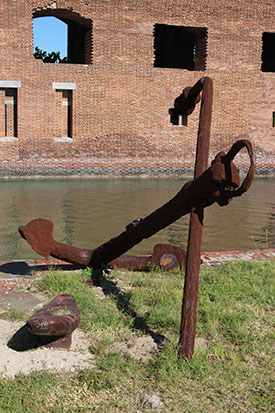 |
Yet due to the function and location of the fort, the Dry Tortugas were once notorious for shipwrecks.
“There are over 200 shipwrecks around the island,” said Kelly Clark, exhibit specialist for the Dry Tortugas National Park.
“Channels of deep water and coral were extremely difficult for ships of the day to navigate. They had to be familiar with the route otherwise there was a real risk of being shipwrecked. That’s why shipwrecks were very common here.”
In spite of the danger imposed by the deep coral, strong currents, and shallow waters of the Dry Tortugas, it was a major shipping route during the 1800s.
“It was a really important seaport highway,” said Melissa Memory, chief of Cultural Resources for the Everglades and Dry Tortugas national parks. “The current would bring them [the ships] past the Tortugas in the Florida Straits to the East Coast.”
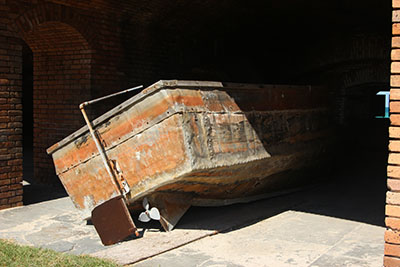 Most of the ships that navigated through the waters of the Dry Tortugas during the early 19th century were merchants carrying cargo for trade between the Spanish, Northeastern Atlantic, Western Caribbean, and Gulf Coast ports.
Most of the ships that navigated through the waters of the Dry Tortugas during the early 19th century were merchants carrying cargo for trade between the Spanish, Northeastern Atlantic, Western Caribbean, and Gulf Coast ports.
During the time of the construction of Fort Jefferson, many of the ships coming to and from the Dry Tortugas carried building materials and equipment.
One of the most popular and explored shipwrecks of the region was the Windjammer Wreck.
Located about a mile southwest of Loggerhead Key, the Avanti, originally named the Killean, was a three-masted Norwegian vessel built in 1875.
“That particular ship is the very height of the sailing technology and was the last generation of ships powered by sail before ships powered by steam started to take over,” said Dave Conlin, chief of Submerged Cultural Resources, the unit that manages the shipwrecks within the National Park Service.
Prior to its wreck in 1907, the Avanti, later named the Windjammer because of its association with the class of sailing vessels known as windjammers, had a long and successful career.
Built in 1875, the Avanti had gone through three different owners before its last voyage through the waters of the Gulf of Mexico.
Throughout its sailing career, the ship served as a cargo vessel that was used for international trade. During its final years, the Avanti was used as a tramp carrier.
In its final journey through the Dry Tortugas, the Avanti was carrying lumber and was most likely making its way to Uruguay from Pensacola.
| The lighthouses of Fort Jefferson were built to help mariners navigate through the waters of the Gulf of Mexico. Loggerhead Lighthouse was built on the most dangerous key of the Dry Tortugas. It was intended to be taller and have a stronger light than the others. | 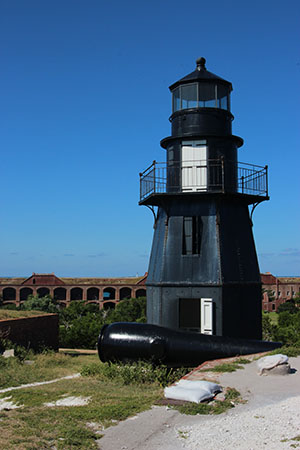 |
“It’s not clear what happened to it, but it looks like it was thrown into a reef by storm and was wrecked in the reef,” said Conlin.
Bird Key wreck, also known as the Brick Wreck, is another commonly explored shipwreck of the Dry Tortugas.
However, Conlin said that it was a pretty small wreck in comparison to the Windjammer.
“It was a steam powered wreck and looks like it was a very small tug boat that was used to help move sailing ships around the Dry Tortugas,” said Conlin.
Although the cause of the Bird Key wreck is unknown, it was discovered that the boat was carrying bricks at the time it was wrecked.
The Windjammer and the Bird Key wreck are the most talked about underwater sites of the Dry Tortugas mainly because they are the wrecks with the most documentation.
“We want to interpret sites that have physical integrity that look like shipwrecks and are recognizable,” said Memory.
Although there are close to 240 casualties in the area, many of the ships were destroyed by wreckers — the pirates of the Dry Tortugas.
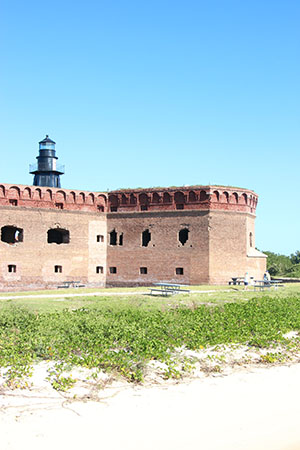 “They didn’t want the other ships to know there was danger there because they wanted other ships to get wrecked so that they could take the cargo,” said Memory. “So they would burn the ships after they took the goods. What is left is metal which gets incrusted with coral and becomes habitat.”
“They didn’t want the other ships to know there was danger there because they wanted other ships to get wrecked so that they could take the cargo,” said Memory. “So they would burn the ships after they took the goods. What is left is metal which gets incrusted with coral and becomes habitat.”
To help alleviate the number of shipwrecks in the region, the U.S. government implemented the construction of lighthouses.
The first lighthouse was the Garden Key lighthouse. However, it was built too short, dim, and far away from the other reefs; another lighthouse was ordered to be built in Garden Key on one of the bastions of the fort.
Shipwrecks, however, were still very common and increased even after both lighthouses were constructed. The U.S. government then ordered another lighthouse to be built.
It was called the Loggerhead Lighthouse. Located on the most dangerous key, Loggerhead Lighthouse was a taller and brighter lighthouse than the other two located on Garden Key.
The lighthouse was maintained lit through World War II until 1982 when the U.S. Coast Guard left the island.
Although the lighthouses helped alleviate the number of shipwrecks, travelers visit the Dry Tortugas to explore the vessels that have now become a part of the Dry Tortugas National Park.
“There are lots of shipwrecks in the Dry Tortugas. While they are an incredible and wonderful thing to see in the Dry Tortugas, there’s also lots of wonders out there that are worth seeing as well,” Conlin said.
Snorkeling and scuba diving allow travelers to explore the wonder of the shipwrecks as well as the marine life that has become a part of those shipwrecks.
Michigan resident Diane Wheelock went snorkeling and explored the waters of the Dry Tortugas through a set of goggles.
“The colors of the water,” is what Wheelock said fascinated her the most.
The shipwrecks, however, are what made the trip to the Dry Tortugas worthwhile for Gean Parzek, a New York resident who was visiting the park with his wife.
“We’re right in the heart of it,” said Parzek.
If You Go
Dry Tortugas National Park
305-242-1100
Entrance fee: $5 (included with ticket price for visitors on Yankee Freedom ferry).
Although Fort Jefferson, located on Garden Key, is the most popular attraction of the Dry Tortugas, there are other small islands to explore as well.
Hours of Operation
Garden Key is open year-round, 24 hours a day; Fort Jefferson is open from sunrise to sunset.
Loggerhead Key is open year-round from sunrise to sunset, but all of the island’s facilities including Loggerhead Lighthouse are closed to the public.
Bush Key is open Oct. 15 – Jan. 15 from sunrise to sunset. Middle and East Keys are open Oct. 16 – March 31 from sunrise to sunset.
Hospital Key and Long Key are close year-round; visitors should remain 100-feet offshore of all closed islands.
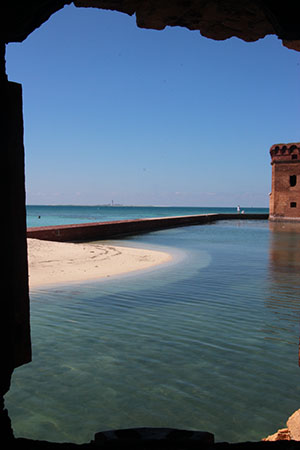 Getting There
Getting There
Since the Dry Tortugas National Park is located in the middle of the Gulf of Mexico, there are only two ways to get to the park—either by boat or by seaplane.
The Yankee Freedom departs daily at 8 a.m. Reservations are required at least two hours prior to departure and can be made online.
The cost is $165 for adults, $155 for students, veterans, and for seniors of at least 62, and $120 for children ages four – 16. The $5 park entrance fee is included in the pricing, as well as on board breakfast and lunch, snorkeling gear and a 40-minute tour of the fort.
For more information, contact the Yankee Freedom at 800-624-0939 or visit http://yankeefreedom.com.
Key West Sea Plane Adventures offers two options. The half-day excursion, a four hour experience, costs $265 for adults, $212 for children 12 and under, and free for children under two.
The full-day excursion, and eight hour adventure, costs $465 for adults, $380 for children 12 and under, and free for children under two.
For more information, contact Key West Sea Plane Adventures at 305-293-9300 or visit http://keywestplanecharters.com.
Travelers can also get to the Dry Tortugas via private boat or charter. For more information, visit http://nps.gov/drto/planyouvisit/directions.
Facilities and Food
Since the fort was built in 1846, facilities are limited. There are no restrooms on the island neither are there any cafeterias or restaurants.
Park visitors traveling on board the Yankee Freedom are provided with a continental breakfast and buffet-style sandwich bar for lunch. The Yankee Freedom also sells snacks and beverages, including alcoholic drinks. Travelers are allowed to bring their own food as well.
The Yankee Freedom is equipped with several restrooms.
Those traveling via Key West Sea Plane Adventures are provided with complementary beverages, but must bring their own food.
Activities
There are plenty of activities at the Dry Tortugas including snorkeling, scuba diving, bird watching, fishing, exploring the fort and camping. For more information on what to do at the park, visit http://www.nps.gov/drto/planyourvisit/outdooractivities.
Camping
A 10-site, primitive campground is located on Garden Key. Eight individual sites can each accommodate up to three two-person tents (a total of six people), and are available on a first-come, first-served basis.
Campsites have picnic tables and grills. Campers must bring all supplies, including fresh water, fuel, ice and food. All trash and garbage must be carried out upon departure.
The campground requires a nightly fee of $3 per person. For more information, visit http://www.nps.gov/drto/planyourvisit/camping.

Comments are Closed